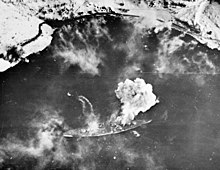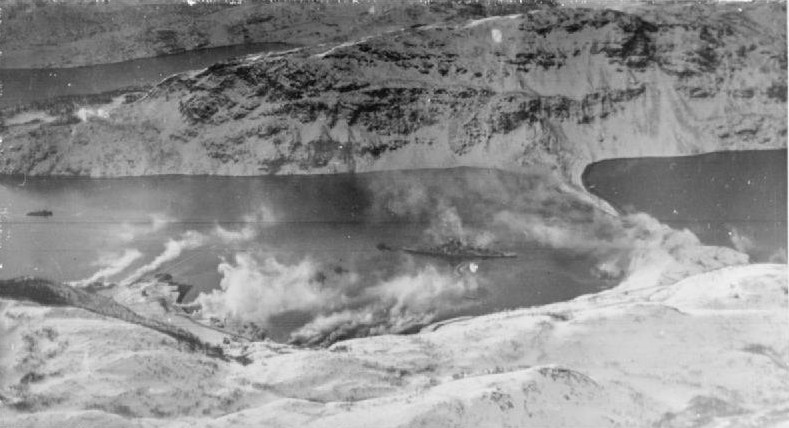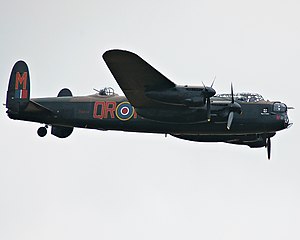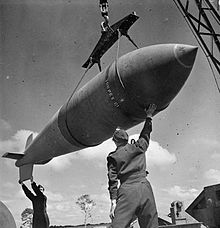
Tirpitz - 1903

Build

Launch
At Sea
Clearing It's Throat
Beginning its war service in 1941, the Tirpitz functions as the flagship of a German Baltic fleet responsible for keeping the Russian fleet at Leningrad in port, patrols the seas off the Aaland Islands, and deploys to Norway to threaten supply convoys bound for the Soviet Union (after the loss of the Bismarck, Hitler forbids the Tirpitz from venturing into the Atlantic). Twice she ventures forth with other German vessels to attack convoys, but both times returns to Norway without firing a shot ... dissuaded by British and Russian vessels in her area of operations. Lack of fuel negates other efforts. Assisted by the battleship Scharnhorst and ten destroyers, in 1943, the Tirpitz participates in the German attack on a small British refueling and weather station on the island of Spitzbergen ... during which she fires fifty-two main-battery shells and eighty-two secondary rounds at various targets on the island, then she goes back into hiding (moving from place to place along the coast and fiords of Norway, the Tirpitz anchors along protective cliffs, covers itself with foraged local trees, and even generates it's own artificial fog, a mixture of water and chlorosulfuric acid).

Tree Camo
Despite its lack of successful attacks and sinkings, the battleship remains a constant threat to British efforts in the area, and a coveted trophy of British Prime Minister Winston Churchill and the British Royal Navy and Royal Air Force who launch attack after unsuccessful attack on the Tirpitz. Seemingly a duel without end, the vessel is attacked while still be finished at Wilhelmshaven, at her Kiel, Germany base, evades all the torpedoes of a group of twelve Albacore torpedo bombers (two are shot down), is missed by the bombs of thirty-three Halifax bombers (five are shot down), avoids being hit during two night raids of seventy-seven bombers (during which seven more bombers re shot down), is missed by four torpedoes fired from the Soviet submarine K-21, avoids an attack of two Chariot human torpedoes when rough seas cause the mission to be aborted. The Tirpitz is finally hit on September 22, 1943, and suffers extensive damage, when she is assaulted in Operation Source, an mine attack by four midget submarines (in the attack, three midgets are sunk, three men are killed, and six sailors are captured).

The Tirpitz Off Norway
The Tirpitz begins 1944 lucky, being missed by the bombs dropped by a group of fifteen Soviet bombers (only four of which reach their target) ... luck which quickly runs out when the battleship is damaged when strafed and hit fifteen times by forty Barracuda bombers and eighty fighters participating in Operation Tungsten (at a cost of four aircraft destroyed, the Germans suffer 122 dead and another three-hundred-sixteen of her crew wounded). And so it goes. Three air raids are scuttled due to bad weather, three more, of almost 200 bombers and fighters, fail to score a single hit, at a cost of six aircraft, seventy-seventy planes of Operation Goodwood score two superficial hits on the battleship, and one-hundred-forty-three aircraft (four-engine Avro Lancaster bombers now being tried) in three more missions gain only one more hit (at the cost of three more planes). The back-and-forth finally ends though on November 12, 1944.

Under Attack During Operation Tungsten

Artificial Fog

Avro Lancaster
The Tirpitz is anchored near Tromso, Norway when it is assaulted at 9:35 in the morning by thirty-two Avro Lancaster bombers (led by commanders A.G. Williams and J.B. Tait) participating in Operation Catechism (a film crew from the Royal Australian Air Force is also along to document the mission), each carrying a twelve thousand pound Tallboy bomb capable of penetrating the battleships heavy armor (the special creation of Sir Barnes Wallis). Calling for help from the Luftwaffe, none is received (the German commander of the fighter base at Bardufoss Air Station, Heinrich Ehrler, will later be put on trial and sentenced to three years in prison), and while the guns of the Tirpitz at first keep her attackers at bay, soon bombs are falling from the sky (they take thirty seconds to reach sea level). Aiming poor, twenty-nine miss the battleship ... but it only takes one of the heavy ordinance to succeed, and two hit the Tirpitz and one is a near miss. Hit between the Anton and Bruno turrets, the aircraft catapult and the funnel, and just missed off the port Caesar turret, seabed and sandbanks placed to prevent capsizing cratered, the battleship lists heavily to port and Captain Hans Meyer orders the Tirpitz abandoned Capsized, men in the water, on deck, and still inside, the battleship. It has taken only ten minutes for the huge ship to go over, and eight minutes later a large explosion rocks the Caesar turret, sending pieces of the structures roof and rotation equipment eighty-two feet into the air and on to swimmers in the water (mission completed the bombers fly on to Russia for refueling before returning back to their basses, all unharmed). Tragedy for the German sailors aboard or in the water, almost one-thousand perish in the sinking of the Tirpitz (eighty-two men will be rescued from inside the ship by cutting through the bottom hull).

Tallboy Bomb

Ehrler
11/12/1944
Sinking the Tirpitz By Frank Wootton

Upside Down

Capsized - Rescue Operations Underway
Sunk
Seaworthy no more, the wreck remains where it capsized ... for awhile. Metal and souvenirs desired, after the war a joint project is put together by Norwegian and German interests, and the Tirpitz is lowly cut up and moved in an operation that lasts from 1948 to 1957 ... a sad farewell for a once mighty fighting ship.

Knife Made From Tirpitz Steel

The Tirpitz
No comments:
Post a Comment